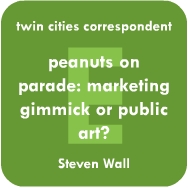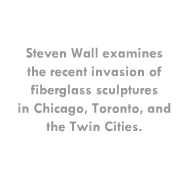

What are we to make of the waves of cattle invading downtown Chicago, moose in Toronto, or cartoon characters holding down street corners in St. Paul? One would probably find these fiberglass sculptures to be quite successful examples of the former while not altogether unworthy of the latter heading labeling them as art.
It does seem a bit preposterous to label the individual units of these events as objects of haute couture; yet, perhaps their true artistic merit may lie in the effect of the pieces as a whole. Each of these events has been labeled, with the full complicity of the local artistic community, as public arts events, yet have also been criticized as mere marketing gimmicks. What is it then that might qualify these objects as art? In my opinion, we need to examine the events not as potential "gallery events" but rather as designators of place and evocative emotional agents.
A world traveler will tell you of the joys of the piazza, the town square or the American walking mall. Places where people come together create a voyeuristic atmosphere of carnivale with extensive benefits to the area's culture and economy. With this in mind, it is amazing what a few life-size gimmicks can do to draw people to a site, creating a modern-style street fair.
Apart from the general attention the moose project generated regarding the status and quality of Toronto's downtown neighborhoods, the city reported an influx of two million tourists to view the sculptures, tourists that spent an estimated $260 million (CA$400 million) and generated an estimated $3.25 million in free, international media coverage. Given a herd size of 326 sculptures, each moose was worth approximately $798,000 to the local business community. The animals garnered an additional $910,000 (CA$1.4 million) contribution to Canadian charities.
Similarly, Chicago reports the 300-strong cattle invasion to have attracted one million visitors spending $200 million in the local economy and generating $3.5 million for charity. While St. Paul declines to place a fiscal impact figure on last year's "Peanuts on Parade" project, estimates figure that 450,000 people were attracted to see the 101 Snoopy statues. While fewer people may have seen Snoopy, auctions of 61 of the statues raised an amazing figure of over $1 million dollars for memorial scholarships and a permanent memorial park for Peanuts creator Charles M. Schultz, a native of the Twin Cities.
But is this art? Having spent two years watching the Peanuts set-up across my street and having interacted personally with the moose and cows, I would have to argue that these mass-produced, designer kewpie dolls do indeed move beyond the basic marketing goal of inducing a preferred action or preference by the masses of people stopping to interact with them.
Although each individual sculpture is based on the same fiberglass mold, local artists were commissioned in each case to personalize the individual piece, creating sculptures that reflect the culture and creativity of the locale. Each artist took on the cultural image and arranged or decorated it in a manner addressing the iconic status of the object, while establishing new and varied relationships between the viewing public and that symbol. This is not to disregard repetition in vision, though the projects as a whole seem to fall a bit short of Warhol's critique of the mass produced object. Much of the creativity actually seemed directed towards establishing a sense of cultural inclusiveness: a moose draped in the colors of the gay rainbow, Snoopy wearing a kilt, a cow as a menorah. Some of the images play off aspects of the iconic imagery, a cow as a source of nourishment, Snoopy as a playmate. Somewhat troublesome perhaps, many of the forms also reflected the contemporary blurring of boundaries between publicly sponsored art and commercial marketing with corporate logos, professional sports team uniforms and blatant product tie-ins co-opting the creative process.
A sense of nostalgia is not the only emotive response generated by these programs. Most apparent with the Snoopy statues in St. Paul, "Peanuts on Parade" has set off a real sense of community and a communal mourning, or memorial, for a friend we have all lost. In the apartments over O'Gara's Bar, Schultz may have drawn the first Snoopy. Ever wonder about the barber pole in the cartoons? His father owned a barbershop on the corner of Snelling and Selby. The boys and girls Schultz captured in comic strips still roam the city, characteristic personalities intact.
The act of viewing the Snoopy statues generated a sense of community amongst the participants. The personality of each Snoopy interacted with each viewer in a unique, subjective way, yet served to strengthen a greater, more objective sense of connectivity, a shared sense of mourning and the ability to even more tightly weave the strands of one's individual life experience into the everyday social fabric of the community - whether you engaged Snoopy representing a member of your particular profession, recognized Snoopy in the uniform of your favorite sports team, viewed Snoopy "participating" in your favorite hobby/sporting passtimes or merely noted him hanging out in your neighborhood. Because of the respect and personal knowledge the Twin Cities hold of Schultz, "Peanuts on Parade" was perhaps uniquely able to evoke a higher emotional engagement on the part of the participants, efficiently serving as signifiers toward more abstract emotions and types onto which we could effectively focus our more abstract feelings in order to sort them out and come to grips with them in this shared, communal environment. It is perhaps no surprise that the individual Snoopy statues were able to raise a respectable $17,000 per statue auctioned to the public.
In this way, the Peanuts-related events in Saint Paul may indicate to the other cities how to most effectively place these fiberglass invasions into a communal context that furthers their effectiveness at representing and defining the community through a public arts event, while avoiding much of the eyebrow raising, high-brow shaking accompanying the proliferation of these events as tourist-aimed marketing endeavors.
Despite the motives of the planning committees, the economic impact of each of these events is doomed to decrease through repetition and proliferation, somewhat as the impact of window displays has seemed to lessen in major department stores. As "fiber-glass sculptural units" becomes a budget category for every city's department of tourism, and as both Saint Paul and Chicago have chosen to follow their successes with new shows, it seems that a bit of future discretion might preserve the fiscal success of the events and promote their cultural impact. While Chicago gets points for having started the fad in North America, by linking the sculptures to a public event - the mourning of a favored son - Saint Paul might have determined the most appropriate usage of this powerful tool. For instance, if each city limited the use of these shows to celebrating the life of a person of local significance, celebrating great events such as anniversaries, or introducing large numbers of tourists drawn to international sporting events, world fairs, etc. to the local culture, the shows would retain their ability to attract further tourist dollars while adding greatly to the local culture as a moment of self-reflection. The increased emotional attachment to the sculptures would also enhance their ability to raise funds for charities.
Some changes to the apparent ground rules might then be in order. Apart from local sports teams, it seems a bit sketchy to justify overt marketing mechanisms in the design of the figures. Compromises may be reached; for instance, Ecolab has sponsored both a Snoopy and a Charlie Brown (2001's "Peanuts on Parade" character) dressed in lab coats, pursuing scientific discovery. The sculptures are well done and seem to celebrate the joys of scientific discovery over an affiliation with a particular corporation. Also, the figures have been placed in a plaza amongst events celebrating summer educational programs for children. A passerby is free to associate the figures with the process of learning in addition to the corporate generosity of Ecolab.
Secondly, the events would be a lot more interesting and perhaps more emotionally effective if artists were freed to explore iconoclasm relative to the images. The beheading of a Snoopy statue by vandals in a low-income Saint Paul neighborhood generated a lot of incidental debate regarding the concepts of community, childhood in an urban setting, and the extent to which shared communal values are linked to economic and racial backgrounds. Opening the images to alternative interpretations could thus deepen participation in the event by other civic communities, thereby expanding the definitions of community and creating a further shared relevance of the icon to the community by which it has been appropriated.
The marketing appeal of the images could also be utilized by the cities to draw others into neighborhoods that desperately need greater integration into the city as a whole. If the sculptures can be empowered through art to help define community and strive to be inclusive through the use of decorative imagery, why not use them to bring people to inner city parks, increase pedestrian traffic in developing neighborhoods and encourage patronage of small businesses that normally cater to more isolated immigrant groups? It would be much more difficult to criticize such programs for lacking artistic merit if the apparent artistic qualities of the programs and their marketing potential were both harnessed to develop the city as a whole. Where's the shame in pandering to tourist dollars if the program also clearly deepens the communities self-knowledge and facilitates further interaction of the cities' many neighborhoods.
Whether art or gimmick, the fiberglass sculpture programs are a demonstrated success. The appeal of the particular images used attracts tourists and money while building up the local community through the artistic power of the sculptures to designate space and the decoration of the forms to create a sense of inclusiveness and participation. The question of art or gimmick may be a question of intent over substance. The answer would thus lie with the city's usage of the event, whether the city values sponsorship appeal over intellectual imagery in the decoration of the individual forms and where the individual forms are placed. By increasing the artistic freedom of expression in the decoration of the forms, and allowing the forms to draw tourists to new destinations within the city, the marketing appeal of the programs may be synergically increased.
But, it would seem that in order for the fiberglass invasions to retain their power - artistically or for drawing crowds, they should be initiated more sparingly with greater attention given to the images' ability to represent or interact with the greatest number of civic communities and preferably organized around events of greater civic significance or self-reflection. Used appropriately, the fiberglass sculpture shows will build the economy, designate space and create a sense of communal discovery and self-retrospection. The market and the arts become paired oxen pulling towards the same goal.